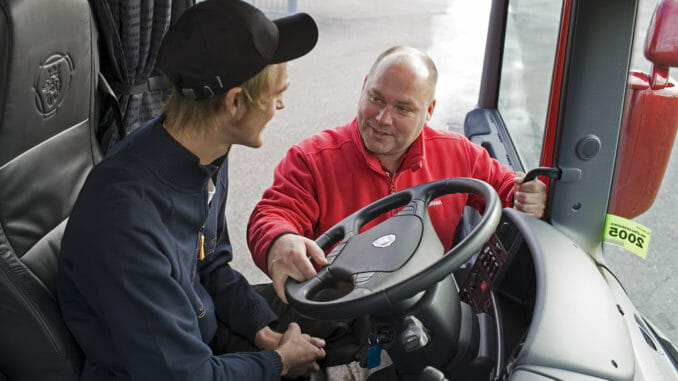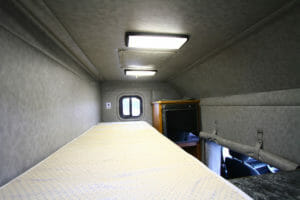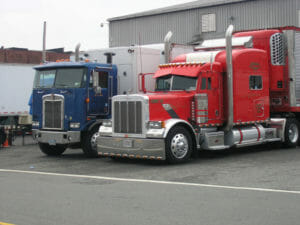
After you’ve gotten your Commercial Driver’s License (CDL) and gone through company orientation, your training is complete, right? Not quite. Once get hired onto your first trucking job, you then go through a short period of OTR driver training.
Trucking companies require on-the-job training, and it’s a unique step to become a truck driver.
If you haven’t chosen a trucking company before you begin truck-driving school, you’ll likely be recruited and hired by the time you finish. After you finish school, you go to one of the company’s terminals.
When you arrive at the terminal, you’ll complete a 2-3 day orientation program and then be assigned to a driver-trainer for trucker training. Different companies have different OTR driver training policies, but generally speaking, it lasts for 1-2 months. During this time, you’ll be paid a set weekly stipend: usually about $400, more or less.
You’ll also get another new experience: you live in the truck with your trainer.
OTR Driver Training: How It Works
For the first week or two, the truck runs solo—while your trainer drives, you’ll be observing (“on duty, not driving”) in the passenger’s seat.

Conversely, when you’re driving, your trainer evaluates your skill and offers help from the passenger’s seat. This is a normal part of the process, so don’t get nervous.
When your trainer trusts you to handle the truck unsupervised, the two of you drive as a team.
When the truck is under a load, it won’t stop. Your trainer drives one shift while you’re asleep in the berth.
When the trainer’s shift is over, you take the wheel while the trainer is in the berth.
This will continue until your trainer is satisfied that you’re ready to graduate from OTR driver training and begin driving on your own (or as part of another team). That usually two weeks to a month.
What to Bring
During your OTR driver training, the truck is the trainer’s home away from home, so most of the room in it will be taken up with his or her belongings. Your trainer provides space for your belongings, but you should pack light. The company will likely give you a list of what to bring. It should include:
- A pillow, sheets and pillowcase, blanket
- Work boots or close-toed shoes, gloves
- Socks, underwear for 7-10 days
- Two or three pairs of long pants and shirts
- A jacket, preferably water-proof
- During winter, cold-weather gear (heavy coat, hat, thick gloves or mittens)
- Toilet kit, necessary and approved medication
- Sunglasses
- Log books, log-book binder or clipboard, fine-point pens
You can bring some extras: certainly your cell phone. A book or two and/or a laptop computer (with electrical cords and a small inverter for charging) are probably okay. Don’t bring large, bulky items: television, CD collection, coffee maker. If your trainer wants those items in his/her truck, he or she will already have them.
Living Conditions During Trucker Training
Your trainer and you are likely strangers who will live and work together in an 8′ X 8′ space for the next 14-60 days. Your trainer has done this before and knows what to expect, but it’ll be a new experience for you, and it can be challenging.

The truck should have two bunks: top and bottom. When the truck is parked, you’ll likely get the top bunk. However, when the truck is rolling, you’ll have to sleep on the bottom bunk.
As well, the two of you will be within a few feet of each other almost always, so personal hygiene, personal habits, and personal problems may become issues.
Both of you will know almost everything each of you do, and almost everything that either of you do will have some effect on the other person.
When team driving starts and sleep patterns get interrupted, patience can wear thin, and tempers can get short.
Avoid shouting and cursing. Maintain good hygiene. Clean up your messes. Keep your gear stowed. Keep the truck neat. Be friendly, not critical. Shower, brush your teeth, and wash your clothes when given the opportunity. Wear clean clothes. Don’t leave dirty sheets on the berth.
In short, make it easy for your trainer to live close to you. Hopefully, your trainer will be just as considerate.
The Trainer Is Your Teacher and Your Immediate Boss.
The trainer makes good money (particularly when the truck runs team), but his or her job is difficult. Your trainer will teach you—and you must learn—to drive the company’s truck under hands-on, real-life conditions. If you can’t handle the truck in the real world, you can’t become a truck driver. It’s that simple.
The trainer also answers for your safety and the safety of the rig and the freight. As a rookie driver, you’ll make plenty of beginner mistakes. Some are mostly harmless, but some can have potentially fatal consequences.
Dangerous situations pop up quickly. As a beginner, you might not see them coming or know how to avoid them before they even happen, but your trainer will. If your trainer says “do this,” or “don’t do that,” it’s usually for a good reason – like saving your butt.

Listen to and watch your trainer and carefully. Ask questions. It’s your job to learn as much as possible. Pay attention. Do as you’re told. Learn.
Also keep in mind that the trainer is monitoring and evaluating your progress as a trainee, your general on-the-job attitude, and your overall ability to handle the OTR driver’s work and lifestyle.
When your trainer explains what he or she is doing, take notice.
Trainers have different styles. Some can be tough on you. Whatever their attitude, your trainer is a valuable source of information about truck-driving in general. They’ll know how the company wants their trucks driven and how to be a good employee.
Most trainers are good people who do their best to be patient with their trainees. Two years down the road, you will likely look back and wonder how your trainer ever put up with you.
Running Team
When the truck runs team, you get your first experience with the challenges of real truck driving. During team driving, the truck is always moving. While you drive, your trainer sleeps. And when you sleep, your trainer drives.
One big challenge is that you’ll be driving when most people have already gone to sleep for the night.
Even with enough sleep, you can still feel stress or fatigue when messing with your normal sleep patterns. Your trainer is a good source of information about how to remain alert.
Staying awake on the road is #1 in importance. Your safety, your trainer’s safety, and the safety of everyone on the road is at stake. You’ll have to get used to driving at night, so find the strategies that work for you. Coffee, stretching. music, anything.
When OTR Driver Training Ends
At the end of trucker training, the company puts you into your own truck. But first, the company may want to give you another final driving test. Some companies do this. Others don’t. If you successfully complete that driving test, then the trucking company officially assigns you to a truck, either as a solo or team driver.

After your OTR driver training ends, your trainer’s dispatcher will route the truck to a terminal or a lot where the company has trucks parked.
The company might assign you to a truck or you might be allowed to choose one.
When you get into the new truck, you should inspect it to make sure it’s ready for the road. If it’s not, the company will make sure to get you a different one.
Once you’ve got a truck and are ready to go, the company assigns you to a dispatcher or “driver manager.” He or she gives you a load assignment, and you’re officially on your way!
Truck driver pay is rising. It’s not unrealistic to plan on making over $60,000 a year with two years of OTR experience. The knowledge, skills, and abilities you get OTR driver training are valuable to start building your experience.
OTR trucking is also hard work, especially for the first year or two, when you’re still learning the best ways to handle it. Orientation and trucker training are difficult. The living conditions are challenging, and you have a lot to learn.
Once you make it past the 2-3 years, you become much more marketable for trucking companies and that’s when the money really starts to come in. So pay attention during training. It’ll serve you well and pay off in the long run, and it’ll also provide you with lifelong memories.
